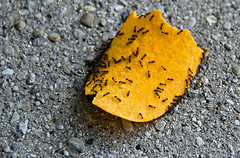
“Silent Spring” (Rachel Carson)
I've actually never read this book, yet.
Human Nature: Comment: The New Yorker :
Elizabeth KolbertThe red imported fire ant, or Solenopsis invicta, is about an eighth of an inch long, with a ruddy-brown body covered in tiny hairs. It feeds mainly on other insects, but will eat just about anything—including electrical equipment—and is reportedly drawn to dirty laundry. A mature colony can contain as many as two hundred and forty thousand individuals and every year produces several hundred potential queens. These queens mate just once, during their “nuptial flight,” then snap off their wings and go looking for a suitable site to start a new colony.
Native to South America, red imported fire ants probably arrived in the United States in cargo ships that docked in Mobile, Alabama, sometime in the nineteen-thirties. By the late forties, they had spread into Florida and Mississippi; by the early fifties, they could be found as far away as Arkansas and North Carolina. Wherever new colonies appeared, trouble followed. The ants attacked young plants and animals, and in humans their bites produced a painful sting accompanied by white pustules. Their mounds, which grew as high as two feet, reduced agricultural yields and damaged farm equipment.Among those who watched the progress of the ants with horror were officials at the United States Department of Agriculture. In 1957, the department decided to eradicate the insects. Its weapons of choice were the pesticides heptachlor and dieldrin, both of which concentrate as they move up the food chain. In 1958, a million acres were sprayed. Quails, woodcocks, wild turkeys, blackbirds, meadowlarks, opossums, and armadillos all began dying off. The U.S.D.A. responded by denying any problems and continuing to spray.
Among those who watched the progress of the U.S.D.A. with horror was Rachel Carson (website here). She concluded that the department had never investigated the pesticides’ toxicity or, if it had, had ignored the results. (Heptachlor causes liver damage, and dieldrin is a neurotoxin.) The department seemed equally clueless about the basic biology of the ants, which continued to spread even as the chemicals rained down. The war against the fire ants was, in Carson’s words, “an outstanding example of an ill-conceived, badly executed, and thoroughly detrimental experiment in the mass control of insects”; it became one of the inspirations for her book “Silent Spring.”

Parenthetic note: As a kid living in East Texas (Burkeville, to be precise), fire ant mounds were plentiful. I spent hours fascinated by their martial prowess, especially interesting when I scooped a shovel-full of ants in one colony and dropped them on a colony a few meters down the road. They always fought to the death. Firecrackers and other flammable substances added to the juvenile mayhem.
Anyway, can we import fire ants to the White House? Wouldn't it be fun to watch Cheney squirm as he's bitten thousands of times?
Six years into the Bush Administration, it’s basically the ant wars all over again. At key agencies, a disregard for inconvenient evidence seems today to be a prerequisite. A memo prepared by the Democratic staff of the House Committee on Oversight and Government Reform in mid-March, for example, revealed that officials of the White House Council on Environmental Quality had made more than a hundred and eighty changes to a status report on global warming, virtually all of which had the effect of exaggerating scientific uncertainties and minimizing certainties. (The official responsible for most of the changes, Philip Cooney, had come to the White House from the American Petroleum Institute and now works for Exxon Mobil.) A second report issued in March—this one by the Inspector General for the Department of the Interior—chronicled numerous instances in which a high-ranking department official, Julie MacDonald, had pressured government scientists to alter findings on threatened species. MacDonald, the report pointedly noted, had “no formal educational background in natural sciences, such as biology.” (MacDonald has since resigned.) As it happened, the report on MacDonald was released the same day that the former second-in-command at the Interior Department, J. Steven Griles, pleaded guilty to lying to Congress.Meanwhile, the Administration has done its best to gut the safeguards put in place after “Silent Spring.” When, for instance, the E.P.A. proposed new rules on mercury emissions from power plants, the proposal turned out to contain several paragraphs lifted, virtually verbatim, from an industry lobbyist’s memos. (With minor changes, those regulations are now in effect.) Just last month, the Administration proposed new rules on the retrofitting of old power plants. The more or less explicit purpose of the rules is to accommodate a power company, Duke Energy, that the E.P.A. had itself sued for violating the Clean Air Act. Also last month, the E.P.A. announced that it would once again delay taking action on two drinking-water contaminants, perchlorate, an ingredient of rocket fuel, and M.T.B.E., a fuel additive.
Technorati Tags: Bush_donor, corruption, environment, EPA
